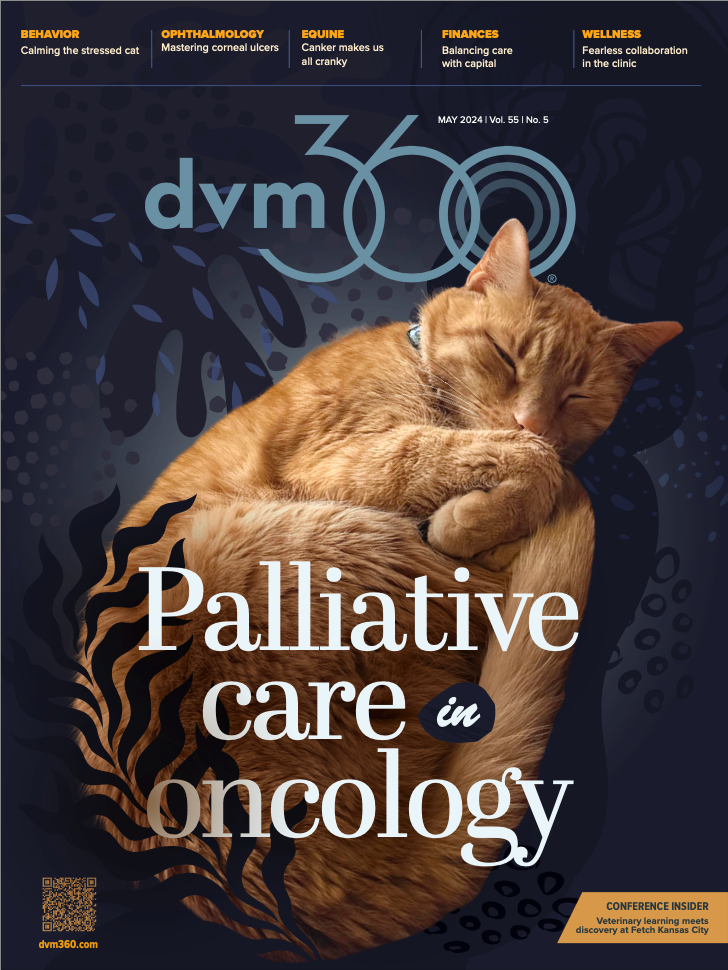Calming the stressed cat
Pheromone diffusers can be a valuable tool for veterinary teams and clients seeking to help relieve their pet’s stress
Photo: mariesacha/Adobe Stock

Coming into the veterinary clinic can be a stressful time for felines, pet owners, and veterinary professionals. If pet owners know their cat does not respond positively to visiting the clinic, it could delay or prevent them from seeking care their pet needs.1 Although a cat’s fear and anxiety can be treated with medications such as gabapentin, some clinics and shelters turn to pheromone diffusers to help calm feline patients in distress.
“This is probably the most widely studied product in all of veterinary medicine. There are studies in cats and in dogs. There are studies looking at effects of the pheromones on relationships between animals, relationships with people, fear of storms, fear of sounds, in shelters, fear in the veterinary clinic, urine marking, [and] behavior in puppies,” Lisa Radosta, DVM, DACVB, owner of Florida Veterinary Behavior Service, said in an interview with dvm360.
“I consider it one of our first-line products. Pheromones are unlikely to do harm and probably will help to some extent with most behavior problems that involve fear, anxiety, and stress. Like everything else, nothing works 100% for every single animal,” she said.
How it works
The late Elizabeth Colleran, DVM, MS, DABVP (Feline), who died in September 2023, explained that pheromones are substances that are secreted from sebaceous and sweat glands, in a 2023 interview with dvm360. Like most mammals, cats communicate with other felines by leaving and detecting messages from pheromones left within the environment by rubbing their face on things, urine marking, or scratching an upright surface. The pheromones create a sense of safety that relieves stress and soothes the cat.
“If you think 'air fresheners,' that’s what we’re talking about here. Only instead of a scent such as lavender or pumpkin pie being infused into an area, it’s a pheromone, a species-specific chemical signal that affects behavior,” explained Terry Curtis, DVM, MS, DACVB, a courtesy clinical assistant professor at the University of Florida College of Veterinary Medicine, in an interview with dvm360. “The pheromone products for use in the veterinary arena are generally used to affect behavior–in a positive way–in cats. These pheromone products can be used as a sole treatment, and in many cases quite successfully, or as part of a multipronged treatment plan,” Curtis added.
What it can be used for
Pheromone diffusers can help calm cats of all ages in various scenarios. Colleran explained that anytime a territorial animal is removed from its home, it will experience arousal and stress. These products can be used to help ease the stress of leaving as well as aggression and social tension that may arise when a family welcomes another feline into the home. In a study funded by Ceva Santé Animale, researchers investigated the efficiency of appeasing pheromone diffusers for managing feline aggression in homes with more than 1 cat.2
For some clients, traveling with pets can be a necessity. For feline patients, pheromones can be sprayed inside the travel carrier before a car or plane trip. A study published by the Journal of Feline Medicine and Surgery investigated how to use a multimodal approach for treating feline stress during air travel.
This study found that using a synthetic analogue of the F3 fraction of the feline facial pheromone has been reported to reduce anxiety in cats that are in unfamiliar surroundings. The researchers also shared that feline facial pheromone treatment reduced somatic stress responses and anxiety-related behavior for cats traveling in a car.3
In conclusion
Although pheromone diffusers can help treat anxiety and keep felines calm in the clinic, they are not an end-all cure. If any pet owner is interested in testing these products, Radosta stated that although it is an option, pheromones do not substitute for providing safe, secure, and enriched environments for feline patients, which is especially important for multicat households.
“What’s nice about these products is that they are easily obtained [no prescription needed], relatively inexpensive, and generally a 'do no harm' effective option," Curtis added. “That said, as with all treatments for pets with behavioral issues, there isn’t any 1 product that is a panacea, a cure-all for all dogs and cats in all situations. But to be honest and transparent, I put a pheromone collar on every dog patient that I see and have done so for the past 20 years. I wouldn’t continue to do so if I—and my clients—didn’t see positive effects.”
Pheromone diffusers are an additional tool that can help with behavior or conflict but are not the solution. Veterinary professionals should encourage clients to speak with them or their team members beforehand if they are interested in using pheromones to help treat their pets.
REFERENCES
- Pereira JS, Fragoso S, Beck A, Lavigne S, Varejão AS, da Graça Pereira G. Improving the feline veterinary consultation: the usefulness of Feliway spray in reducing cats’ stress. J Feline Med Surg. 2016;18(12):959-964. doi:10.1177/1098612X15599420
- DePorter TL, Bledsoe DL, Beck A, Ollivier E. Evaluation of the efficacy of an appeasing pheromone diffuser product vs placebo for management of feline aggression in multi-cat households: a pilot study. J Feline Med Surg. 2019;21(4):293-305. doi:10.1177/1098612X18774437
- Jahn K, DePorter T. Feline stress management during air travel: a multimodal approach. J Feline Med Surg. 2023;25(1):1098612X221145521. doi:10.1177/1098612X221145521
Newsletter
From exam room tips to practice management insights, get trusted veterinary news delivered straight to your inbox—subscribe to dvm360.
